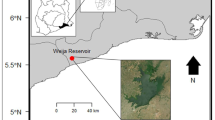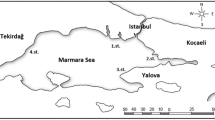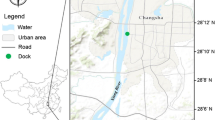Abstract
Heavy metals are continuously released into the oceans from both natural and anthropogenic sources. They are serious threats to both ecosystem and human health because of their toxicity, persistence, bioaccumulation, and biomagnification. We present metal concentrations in the economically important bluefish from Iskenderun Bay, providing valuable information on Northeastern Mediterranean aquatic ecosystem health, as well as the human health risk. The concentrations of manganese, iron, copper, zinc, selenium, cadmium, lead, and mercury were determined in the gill, liver, and muscle tissues of bluefish (Pomatomus saltatrix) caught in Iskenderun Bay (Turkey) during four seasons. Samples were analysed via inductively coupled plasma mass spectrometer. Fe and Zn were detected in the highest concentrations during all four seasons. The ranges of Fe concentrations were 61.15–108.76, 229.78–377.02, and 6.35–8.63 and those of Zn were 25.21–44.25, 42.25–76.08, and 6.27–13.59 in the gills, livers, and muscles, respectively. In contrast, Hg and Cd were not found in the bluefish tissues in any season with the exception of Cd in the gills during the spring (0.757 mg/kg, above the legal limit of 0.5 mg/kg). On a seasonal basis, no meaningful accumulation trend was observed for the muscles or gills, while the highest concentrations of Mn, Fe, Cu, Zn, and Se in the liver were found in the spring. Liver tissues possessed higher metal concentrations than gill and muscle tissues. Estimated daily and weekly intakes of the metals due to human consumption of the bluefish were considerably lower than the provisional tolerable intake. In this study, there was an inflow of metals into Iskenderun Bay; however, no significant metal accumulation was found in bluefish tissues at a rate that would harm human health.



Similar content being viewed by others
References
Abadi DRV, Dobaradaran S, Nabipour I, Lamani X, Ravanipour M, Tahmasebi R, Nazmara S (2015) Comparative investigation of heavy metal, trace, and macro element contents in commercially valuable fish species harvested off from the Persian Gulf. Environ Sci Pollut Res 22(9):6670–6678. https://doi.org/10.1007/s11356-014-3852-1
Al-Ghanim KA, Mahboob S, Seemab S, Sultana S, Sultana T, Al-Misned F, Ahmed Z (2016) Monitoring of trace metals in tissues of Wallago attu (lanchi) from the Indus River as an indicator of environmental pollution. Saudi J Biol Sci 23(1):72–78. https://doi.org/10.1016/j.sjbs.2015.03.012
Ali H, Khan E (2018) Bioaccumulation of non-essential hazardous heavy metals and metalloids in freshwater fish. Risk to human health. Environ Chem Lett 16(3):903–917. https://doi.org/10.1007/s10311-018-0734-7
Ali Z, Yousafzai AM, Sher N et al (2021) Toxicity and bioaccumulation of manganese and chromium in different organs of common carp (Cyprinus carpio) fish. Toxicol Rep 8:343–348. https://doi.org/10.1016/j.toxrep.2021.02.003
Anvari Far H, Amirkolaie AK, Jalali AM et al (2018) Environmental pollution and toxic substances: Cellular apoptosis as a key parameter in a sensible model like fish. Aquat Toxicol 204:144–159. https://doi.org/10.1016/j.aquatox.2018.09.010
Arain MB, Kazi TG, Jamali MK, Jalbani N, Afridi HI, Shah A (2008) Total dissolved and bioavailable elements in water and sediment samples and their accumulation in Oreochromis mossambicus of polluted Manchar Lake. Chemosphere 70(10):1845–1856. https://doi.org/10.1016/j.chemosphere.2007.08.005
Çetin E, Güher H, Gaygusuz ÇG (2013) The investigation of heavy metal accumulation of some fishes in Altınyazı dam lake (Edirne-Turkey) Aquat Sci Eng 31(1): 1–14. https://doi.org/10.18864/TJAS201601
D-A-CH (Deutsche Gesellschaft für Ernährung - Österreichische Gesellschaft für Ernährung - Schweizerische Gesellschaft für Ernährungsforschung - Schweizerische Vereinigung für Ernährung), (2013) Referenzwerte für die Nährstoffzufuhr. Neuer Umschau Buchverlag, Frankfurt/Main, Germany, p 292
Dick PT, Dixon DG (1985) Changes in circulating blood cell levels of rainbow trout, Salmo gairdneri Richardson, following acute and chronic exposure to copper. J Fish Biol 26(4):475–481. https://doi.org/10.1111/j.1095-8649.1985.tb04287.x
Dobaradaran S, Naddafi K, Nazmara S, Ghaedi H (2010) Heavy metals (Cd, Cu, Ni and Pb) content in two fish species of Persian gulf in Bushehr Port. Iran Afr J Biotechnol 9(37):6191–6193
EC (2006) European Union Commission regulation (1881/2006), maximum levels for certain contaminants in foodstuffs. J Eur Union 50:5–14
European Commission (1997) Draft commission regulation setting limits for certain contaminants in food stuffs. DocIII/5125/95/REV.3.
European Commission (2006) Commission regulation (EC) no. 1881/2006 of 19 December 2006 setting maximum levels for certain contaminants in foodstuffs. J Eur Union L364–5/L364–24
EFSA Panel on Dietetic Products, Nutrition and Allergies (NDA) (2013) Scientific opinion on dietary reference values for manganese. EFSA J 11(11):3419
El-Moselhy KhM, Othman AI, Abd El-Azem H, El-Metwally MEA (2014) Bioaccumulation of heavy metals in some tissues of fish in the Red Sea. Egypt Egyptian J Basic Appl Sci 1:97–105. https://doi.org/10.1016/j.ejbas.2014.06.001
EPA 2008. U.S. Environmental Protection Agency. Manganese compounds. http://www.epa.gov/ttn/atw/hlthef/manganes.html.
Erkan N, Özden Ö, Ulusoy Ş (2011) Seasonal micro-and macro-mineral profile and proximate composition of oyster (Ostrea edulis) analyzed by ICP-MS. Food Analyt Methods 4(1):35–40. https://doi.org/10.1007/s12161-010-9128-6
Ersoy B, Çelik M (2010) The essential and toxic elements in tissues of six commercial demersal fish from Eastern Mediterranean Sea. Food Chem Toxicol 48:1377–1382. https://doi.org/10.1016/j.fct.2010.03.004
FAO (Food and Agriculture Organization) (1983) Compilation of legal limits for hazardous substances in fish and fishery products. In: FAO Fishery Circular No. 464. Food and Agriculture Organization of the United Nations, Rome, pp 5–10
FAO/WHO (2011) Joint FAO/WHO Food Standards Programme Codex Committee on Contaminants in Foods, Food CF/5 INF/1. Fifth Session. The Hague, The Netherlands
Hussein A, Khaled A (2014) Determination of metals in tuna species and bivalves from Alexandria. Egypt Egyptian J Aquat Res 40(1):9–17. https://doi.org/10.1016/j.ejar.2014.02.003
Junejo SH, Baig JA, Kazi TG et al (2019) Cadmium and lead hazardous impact assessment of pond fish species. Biol Trace Element Res 191(2):502–511. https://doi.org/10.1007/s12011-018-1628-z
Kalay M, Canlı M (2000) Elimination of essential (Cu, Zn) and non-essential (Cd, Pb) metals from tissues of a freshwater fish Tilapia zilli. Turkish J Zool 24(4):429–436
Kir I, Tumantozlu H (2012) Investigation of some heavy metal accumulation in water, sediment, and carp (Cyprinus carpio) samples of Karacaoren-II dam lake. Ekoloji 21(82):65–70
Kosswig C (1953) Some features of fisheries in Turkey (in Turkish). Hidrobiyoloji Mecmuası A 1(4):145–153
McKenzie RC, Rafferty TS, Beckett GJ (1998) Selenium: an essential element for immune function. Immunol Today 19(8):342–345
Mulk S, Korai AL, Azizullah A, Shahi L, Khattak MNK (2017) Marble industry effluents cause an increased bioaccumulation of heavy metals in Mahaseer (Tor putitora) in Barandu River, district Buner. Pakistan Environ Sci Pollut Res 24(29):23039–23056. https://doi.org/10.1007/s11356-017-9921-5
Mzimela HM, Wepener V, Cyrus DP (2003) Seasonal variation of selected metals in sediments, water and tissues of the groovy mullet, Liza dumerelii (Mugilidae) from the Mhlathuze Estuary. South Africa Mar Pollut Bull 46(5):659–664. https://doi.org/10.1016/S0025-326X(03)00088-2
Omwenga I, Kanja L, Nguta J, Mbaria J, Irungu P (2014) Assessment of lead and cadmium residues in farmed fish in Machakos and Kiambu counties. Kenya Toxicol Environ Chem 96(1):58–67. https://doi.org/10.1080/02772248.2014.911541
Ongeri DM, Lalah JO, Wandiga SO, Schramm KW, Michalke B (2012) Seasonal variability in cadmium, lead, copper, zinc, and iron concentrations in the three major fish species, Oreochromis niloticus, Lates niloticus and Rastrineobola argentea in Winam Gulf, Lake Victoria: Impact of wash-off into the lake. Bull Environ Contam Toxicol 88(2):166–171. https://doi.org/10.1007/s00128-011-0472-z
Özden Ö (2010) Seasonal differences in the trace metal and macrominerals in shrimp (Parapenaus longirostris) from Marmara Sea. Environ Monitor Assess 162(1–4):191–199. https://doi.org/10.1007/s10661-009-0787-y
Özden Ö (2013) Monitoring programme on toxic metal in bluefish (Pomatomus saltatrix), anchovy (Engraulis encrasicolus) and sardine (Sardina pilchardus) from Istanbul, Turkey: Levels and estimated weekly intake. Bull Environ Contam Toxicol 90(5):542–551. https://doi.org/10.1007/s00128-012-0958-3
Özkütük AS, Özyurt G, Özyurt CE (2017) Metal concentrations in fish species from the northeast Mediterranean Sea (Karataş and Iskenderun Bay) in the New Millennium", Ecology 2017 International Symposium. Kayseri, Turkey 11–13:1–1
Özogul Y, Özogul F, Alagoz S (2007) Fatty acid profiles and fat contents of commercially important seawater and freshwater fish species of Turkey: a comparative study. Food Chem 103(1):217–223. https://doi.org/10.1016/j.foodchem.2006.08.009
Öztürk DK, Baki B, Karayücel İ, Öztürk R, Gören GU, Karayücel S (2019) Determination of seasonal vitamin and mineral contents of sea bream (Sparus aurata L., 1758) cultured in net cages in central Black Sea region. Biol Trace Element Res 187(2): 517–525. https://doi.org/https://doi.org/10.1007/s12011-018-1382-2
Saha N, Mollah MZI, Alam MF, Rahman MS (2016) Seasonal investigation of heavy metals in marine fishes captured from the Bay of Bengal and the implications for human health risk assessment. Food Control 70:110–118. https://doi.org/10.1016/j.foodcont.2016.05.040
Saiki MK, Castleberry DT, May TW, Martin BA, Bullard FN (1995) Copper, cadmium, and zinc concentrations in aquatic food chains from the upper Sacramento River (California) and selected tributaries. Arch Environ Contam Toxicol 29(4):484–491
Satarug S, Baker JR, Urbenjapol S, Haswell-Elkins M, Reilly PE, Williams DJ, Moore MR (2003) A global perspective on cadmium pollution and toxicity in non-occupationally exposed population. Toxicol Lett 137(1–2):65–83. https://doi.org/10.1016/S0378-4274(02)00381-8
Sonone SS, Jadhav S, Sankhla MS et al (2020). Water contamination by heavy metals and their toxic effect on aquaculture and human health through food chain. Letters in Applied NanoBioScience 10(2): 2148–2166. https://doi.org/https://doi.org/10.33263/LIANBS102.21482166
TUIK 2019. Fishery Production Statistics of Tukey. Turkish Statistical Institute. www.tuik.gov.tr
Türkmen A, Türkmen M, Tepe Y, Akyurt I (2005) Heavy metals in three commercially valuable fish species from Iskenderun Bay, Northern East Mediterranean Sea. Turkey Food Chem 91(1):167–172. https://doi.org/10.1016/j.foodchem.2004.08.008
Türkmen M, Türkmen A, Tepe Y, Ateş A, Gökkuş K (2008) Determination of metal contaminations in seafoods from Marmara, Aegean, and Mediterranean seas: twelve fish species. Food Chem 108(2):794–800. https://doi.org/10.1016/j.foodchem.2007.11.025
Türkmen A, Tepe Y, Türkmen M, Mutlu E (2009) Heavy metal contaminants in tissues of the Garfish, Belone belone L., 1761, and the Bluefish, Pomatomus saltatrix L., 1766, from Turkey waters. Bull Environ Contam Toxicol 82(1): 70–74. https://doi.org/https://doi.org/10.1007/s00128-008-9553-z
Türkmen A, Türkmen M, Tepe Y, Çekiç M (2010) Metals in tissues of fish from Yelkoma Lagoon, northeastern Mediterranean. Environ Monitor Assess 168(1–4): 223–230. 230. https://doi.org/https://doi.org/10.1007/s10661-009-1106-3
Vinodhini R, Narayanan M (2008) Bioaccumulation of heavy metals in organs of freshwater fish Cyprinus carpio (Common carp). Int J Environ Sci Technol 5(2):179–182
Waheed S, Kamal A, Malik RN (2014) Human health risk from organ-specific accumulation of toxic metals and response of antioxidants in edible fish species from Chenab River. Pakistan Environ Sci Pollut Res 21(6):4409–4417. https://doi.org/10.1007/s11356-013-2385-3
Wei Y, Zhang J, Zhang D, Tu T, Luo L (2014) Metal concentrations in various fish organs of different fish species from Poyang Lake, China. Ecotoxicol Environ Saf 104:182–188. https://doi.org/10.1016/j.ecoenv.2014.03.001
WHO (1987) World Health Organisation; Environmental health criteria 58: Selenium international programme on chemical safety. World Health Organisation, Geneva
Yilmaz AB (2003) Levels of heavy metals (Fe, Cu, Ni, Cr, Pb, and Zn) in tissue of Mugil cephalus and Trachurus mediterraneus from Iskenderun bay. Turkey Environ Res 92(3):277–281. https://doi.org/10.1016/S0013-9351(02)00082-8
Yılmaz AB, Sangun MK, Yaglioglu D, Turan C (2010) Metals (major, essential to non-essential) composition of the different tissues of three demersal fish species from Iskenderun Bay, Turkey. Food Chem 123:410–415. https://doi.org/10.1016/j.foodchem.2010.04.057
Yuen HW, Becker W (2019) Iron toxicity. StatPearls Publishing LLC, Treasure Island, FL, USA
Acknowledgements
The authors thank The Research Foundation of Cukurova University (Project No: FBA2017-7834) for its financial support.
Author information
Authors and Affiliations
Corresponding author
Ethics declarations
Conflicts of interest
The authors declare no conflict of interest.
Rights and permissions
About this article
Cite this article
Özyurt, G., Tabakoğlu, Ş.S. & Özyurt, C.E. Metal Bioaccumulation in the Gill, Liver, and Muscle of Bluefish (Pomatomus saltatrix) From the Northeastern Mediterranean and Human Health Risk Assessment Associated with Their Seasonal Consumption. Arch Environ Contam Toxicol 81, 58–66 (2021). https://doi.org/10.1007/s00244-021-00852-0
Received:
Accepted:
Published:
Issue Date:
DOI: https://doi.org/10.1007/s00244-021-00852-0




